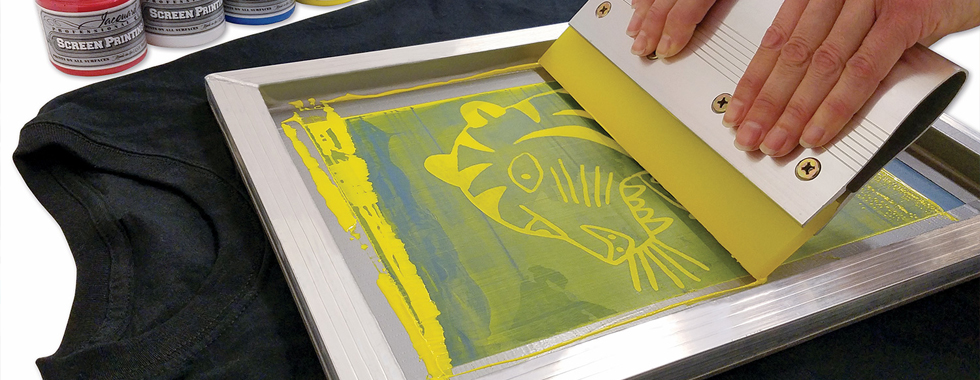The Essential Guide to Comprehending Screen Printing and Its Versatile Makes use of
Screen printing has a rich history that dates back to ancient times, evolving into an advanced technique made use of across different sectors today. This guide checks out the complexities of the screen printing procedure, describing its applications in style, home, and advertising décor - 10:9 Design Screen Printing. Understanding these fundamentals can open up creative potential for both artistic and industrial jobs. The complying with areas will certainly reveal necessary tips and methods to improve one's screen printing endeavors
The History of Screen Printing
Screen printing has origins that trace back centuries, its evolution mirrors the imaginative and technological improvements of various cultures. Coming from in old China, the method was initially made use of for embellishing fabrics and later spread to Japan, where it ended up being important to Ukiyo-e woodblock printing. The technique shifted to Europe in the 18th century, where it acquired popularity amongst craftsmens and business printers. The innovation of photo emulsion in the 20th century transformed screen printing, permitting even more intricate layouts and better performance. Musicians like Andy Warhol further propelled its popularity, making use of the medium to create famous jobs that blended commercialism and art. By the late 20th century, screen printing had established itself as a versatile technique, utilized in fashion, advertising, and great art. Today, it proceeds to advance, incorporating digital technology and expanding its applications throughout numerous industries.
The Screen Printing Refine Explained
Screen printing changes creative visions into tangible designs with a series of exact steps. A photo is produced and then moved onto a screen, normally made of fine mesh material stretched over a framework. A light-sensitive emulsion is put on the screen, which is exposed to light, setting in locations not covered by the image. After washing out the unhardened solution, a pattern is created.
Next, the screen is positioned over the substratum, whether it be material, paper, or one more material. Ink is then pressed through the open areas of the stencil making use of a squeegee, transferring the style onto the substratum below. This procedure can be duplicated for numerous colors, requiring separate displays for every shade. The published item is treated using warmth to ensure the ink adheres appropriately, resulting in a sturdy, vivid design all set for usage.
Sorts Of Screen Printing Techniques

Additionally, specialized techniques, such as discharge screen printing, get rid of dye from the material to produce softer prints, while aluminum foil screen printing uses metal foil to achieve a shiny finish (10:9 Design Screen Printing Texas). Each strategy provides distinctive features, accommodating numerous creative demands and production ranges, eventually increasing the opportunities within the screen printing domain name
Applications of Screen Printing in Various Industries

Furthermore, the signage and advertising sectors utilize screen printing for developing appealing display screens and banners. This technique enables strong shades and intricate layouts that record interest. In electronics, screen printing is used for using conductive inks to circuit boards, important for component links. The home decoration industry accepts screen printing to produce unique layouts on textiles and wall art. Generally, screen printing serves as a crucial device across diverse areas, boosting items with personalized and visually attractive graphics.
Tips for Successful Screen Printing Projects
While taking on a screen printing project, mindful attention to detail can considerably boost the final end result. First, choosing top quality materials is essential; this consists of the screen, inks, and substrates. Utilizing ideal mesh counts can impact ink deposition and information resolution. Prep work is just as essential; extensive cleaning of displays and correct direct exposure times ensure crisp prints.
Next off, accurate enrollment is vital for multi-color prints. Making use of placement tools can help attain accurate layering. Additionally, screening prints on scrap materials prior to manufacturing assists identify possible concerns without squandering resources.

Frequently Asked Questions
What Materials Are Finest for Screen Printing on Material?
Cotton and polyester blends are excellent for screen printing on fabric as a result of their toughness and ink absorption. In addition, specialty textiles like silk or canvas can create special structures and finishes, enhancing the general design high quality.
How Do I Clean and Maintain Screen Printing Equipment?
To clean and preserve screen printing equipment, one need to on a regular basis clean displays with suitable solvents, inspect mops for wear, lubricate moving components, and store all things in a completely dry, dust-free atmosphere to extend their lifespan.
What Are the Ecological Impacts of Screen Printing?
Screen printing can have significant environmental effects, consisting of chemical waste from inks and solvents, water usage throughout cleaning processes, and power consumption. Sustainable practices and green products are crucial for minimizing these adverse effects.
Can Screen Printing Be Done in your home Effectively?
Screen printing can be effectively done at home with the ideal products and methods. Hobbyists can create top quality prints, though success relies on their ability degree, devices, and understanding of the procedure entailed.
What Are the Costs Linked With Starting a Display Printing Organization?

Beginning a screen printing organization entails costs for devices, products, and work space. Initial expenditures usually range from a couple of hundred to a get more info number of thousand bucks, depending on the scale, high quality of machinery, and desired production capability.
Screen printing has a rich history that dates back to old times, advancing into a sophisticated technique utilized throughout different industries today. One more technique, rotary screen printing, employs cylindrical displays, facilitating continuous printing on fabric rolls, consequently boosting performance for large productions. Furthermore, specialized strategies, such as discharge screen printing, eliminate dye from the textile to develop softer prints, while aluminum foil screen printing uses metal foil to achieve a shiny surface. In the fashion market, screen printing is commonly used to develop lively styles on clothing, allowing brand names to display their unique designs. Cotton and polyester blends are perfect for screen printing on textile due to their durability and ink absorption.